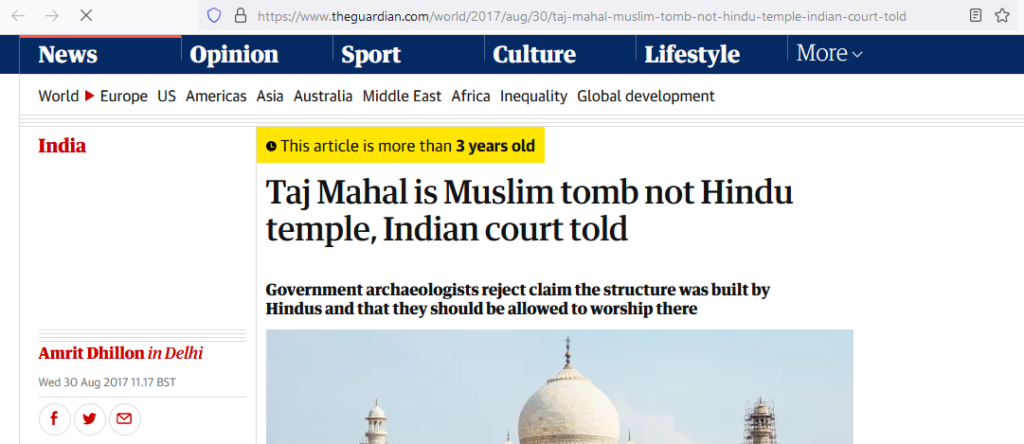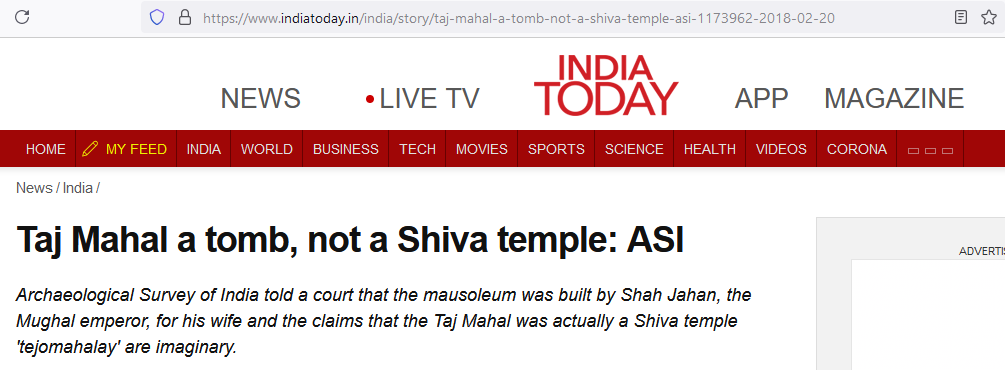Is Professor’s claim that Taj Mahal is actually a Hindu temple called Tejo Mahalaya, true?
A post, that is going viral on social media platforms, says the Taj Mahal is an ancient “Lord Shiva Temple” named “Tejo Mahalaya” using Professor PN Oak’s book as source.
Claim: The claim titled “Reality Unleashed”, “Taj Mahal, the hidden truth” says that the iconic monument Taj Mahal is, in reality, a Lord Shiva temple named “Tejo Mahalaya”. To support the viral claim, Professor PN Oak’s book “Taj Mahal, the True Story: The Tale of a Temple Vandalized” is being used. In his book, Oak claimed that the monument was constructed in 1155 AD, centuries before the Mughals invaded India, and not in the 17th century(as claimed by the Archaeological Survey of India). The post has garnered thousands of likes across social media platforms and has also been shared a lot of times.
The claim is doing rounds on twitter for the last few days.
बहुत ही गहरी और सच्ची तस्वीर आप सब देख लीजिए यही एकदम सही है। हर हर महादेव🚩 @YogiDevnath2 @TheDeepak2020In pic.twitter.com/uj0jiHdlTy
— Narendra Singh🇮🇳 (@NarendrasingBJP) June 13, 2021
और कितना दबाओगे..जहां जहा जाओगे सनातन धर्म ही पाओगे…!!❤️👇 pic.twitter.com/MBuHyKiFVJ
— NIGHTINGALE SNEHA (@Nightingle_Girl) June 13, 2021
Hinduism Now, a community group on Facebook, shared this viral post claiming that the Taj Mahal is actually a temple called “Tejo Mahalaya” and the claim is based on Professor PN Oak’s book “Taj Mahal, the True Story: The Tale of a Temple Vandalized”. The post amassed a whopping 11 thousand likes and was also shared more than two thousand times. Similarly, Hindu, another purported community group on Facebook shared the same post and it garnered more than a thousand likes. Both these groups based their claims on Oak’s book. PN Oak in his book argued that the Taj Mahal was originally a temple built by a Rajput ruler and it was later seized by the Mughal emperor Shah Jahan.
Truth
No this viral claim of Professor PN Oak, that says the Taj Mahal is an ancient “Lord Shiva Temple” called “Tejo Mahalaya” is false.
During the course of our investigation, we found out that this claim keeps on resurfacing on several social media platforms every now and then.
In 2000, Professor PN Oak had filed a petition in the Supreme Court in regards to his claim but the Supreme Court dismissed it as “a bee in the bonnet” theory.
“History shows conquerors all over the world converting existing monuments to suit their own ideas,” said Parsa Venkateshwar Rao, an author and columnist. “But this claim about the Taj is absurd because features such as the dome and minaret cannot be found in earlier periods and it is silly for the judge to have even allowed the petition.” Oak, who died in 2007, took his claim as far as the supreme court in 2000 where it was thrown out as no more than a “bee in his bonnet”.”

The Archaeological Survey of India has many a time mentioned in the past that the Taj Mahal is a tomb. The ASI also denied the claims that the mausoleum was built on a Lord Shiva temple.

In addition to that, the Central Information Commission in a clarification mentioned that no record could suggest that the Taj Mahal was once upon a time a temple called “Tejo Mahalaya”.

- Is Rahul Gandhi’s name misspelled on a Congress Party hoarding in Wayanad? - August 4, 2021
- Has CM ‘Yogi Adityanath’ not taken even a single penny as salary? - August 2, 2021
- Did lakhs of ‘Shiva Lingas’ surface in the Shivakashi river bed? - July 31, 2021




